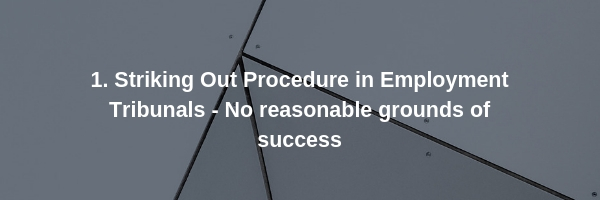Our Monthly Employment Law Updates provide a summary of some of the most important cases, helping our clients to stay up-to-date on recent case law developments. These updates are primarily aimed at in-house employment lawyers but may also be of interest to HR professionals who wish to be updated on developments in employment law.
May’s Employment and HR update covers the following;
1.Striking Out Procedure in Employment Tribunals – No reasonable grounds of success
2. Geographical jurisdictional issues in the Employment Tribunal
3. Pay during shared parental leave & sex discrimination
4. Promoting mental wellbeing in the workplace

In order to have all or part of a claim struck out by the Employment Tribunal prior to a final hearing, certain strict grounds must be met:
• The claim or argument is scandalous, vexatious or has no reasonable grounds of success;
• The manner in which the proceedings have been conducted have been scandalous, unreasonable or vexatious;
• One of the parties has not complied with any of the Tribunal’s rules or with an order of the Tribunal (including a deposit order);
• The claim has not been actively pursued;
• It is no longer possible to have a fair hearing.
In the case of Mbuisa v Cygnet Healthcare Limited, the Claimant was employed for a number of months before resigning due to health and safety concerns (the concerns included assaults, threatened assaults and being asked to carry out lifting work) he raised to his employer that were not acted upon.
The Claimant subsequently started proceedings, with part of his claim consisting of a claim for constructive unfair dismissal for health and safety reasons under s100 of the Employment Rights Act 1996 (‘ERA’). Under s100 of the ERA, if it is established that the reason for dismissal is due to a health and safety reason, then it is automatically deemed to have been unfair.
The Employment Tribunal gave its initial view, commenting that the constructive unfair dismissal claim had little reasonable prospect of success and gave the Claimant the opportunity to make written representations confirming why it should not be struck out. Following the Claimant’s written representations, the Tribunal stated that the Claimant had not shown how the breaches of contract (relating to the actual and threatened assaults and lifting work) fell within s100 of the ERA and that this aspect of his claim had no reasonable prospect of success, subsequently striking it out.
The Claimant appealed and the Employment Appeal Tribunal (‘EAT’) allowed the appeal. It held that the Tribunal had made an error in striking out the claim, failing to understand the Claimant’s argument for constructive unfair dismissal under s100 of the ERA.
The EAT commented that striking out a claim on the grounds of it having no reasonable prospects of success was a draconian step, only to be used in exceptional circumstances and that it would be wrong to do so if there was a dispute on facts that needed to be determined at trial. The EAT further commented that caution should be taken where a case is badly pleaded, which could arise in situations where a claimant is a litigant in person (someone who does not have legal representation), whose first language is not English or where they may not have experience in articulating complex arguments in written form.
Note for employers: This case is a reminder to employers that if they are seeking to have a claimant’s claim struck out as a preliminary issue ahead of a final hearing due to it having “no” reasonable prospects of success, it will only be given in exceptional circumstances and very rarely when there is a dispute in facts which need to be dealt with via witness evidence at a final hearing. The EAT emphasised in this case that it would have been a better course of action for a deposit order to be made if the Tribunal was still of the view that the case had “little” reasonable prospect of success. A deposit order can be made by an Employment Judge if they consider an argument has “little” reasonable prospect of success and requires the party who wants to continue with this specific argument to pay a deposit to the Tribunal in order to be able to do so. If the deposit is not paid, that specific argument will be struck out. It is therefore advisable from a tactical perspective when defending a Tribunal claim to make an application for a deposit order alongside an application for strikeout to there is a fall-back position should the strike out not be awarded.

The Claimant, a French lawyer working in Paris, brought claims for equal pay, direct sex and race discrimination and victimisation against the Respondents (a UK-based international law firm and one of its partners individually), and the issue arose of whether the case should be heard in England or France. The Tribunal found that it had “international jurisdiction” over the claims, but on the facts the Claimant worked exclusively in France, and so the claims fell outside the Tribunal’s territorial jurisdiction and should be brought in France.
The Tribunal originally stated that the Claimant did not have a strong enough connection to the UK for the claims to be heard here; she only made ad hoc, infrequent visits to the London office in relation to her work and her role was almost entirely based in France and regarding French law. The alleged acts took place in Paris and were therefore outside the Employment Tribunal’s jurisdiction. It was also accepted that the Claimant would have had an available remedy to her issues under French jurisdiction.
The EAT commented that the Brussels I Recast Regulations applied to this case, which meant both the firm and the individual could in principle be sued in England as the firm was domiciled in London. However, the EAT concluded that they would have come to the same conclusion as the Tribunal judge; the weight of the facts indicated that the Claimant worked in France and therefore the claims should be litigated there, the claims were therefore dismissed.
Note for employers:
The Lawson v Serco [2006] UKHL 3, House of Lords decision tests still apply when establishing if a claimant has jurisdiction to bring Tribunal claims in Great Britain:
• Standard cases: employees ordinarily working in Great Britain. The question is whether the employee was working in Great Britain at the time of their dismissal, or the matter complained of. A casual visitor to Great Britain will not be protected.
• Peripatetic employees, such as airline pilots, cabin crew, management consultants or salesmen. A peripatetic employee’s base should be treated as their place of employment, and therefore peripatetic employees will normally be protected if their base is Great Britain. There may be a number of factors which cast light on where the employee is based, including:
• where the employee has their headquarters, or where their travels begin and end (this, in practice, is likely to be the decisive factor);
• where the employee has their home;
• where the employee is paid and in what currency; and
• whether the employee is subject to National Insurance contributions.
• Expatriate employees: an employee who lives and works entirely or almost entirely abroad. Where an employee is working and based abroad, the fact that they were recruited in Britain by a British employer will not be sufficient to bring them within the ERA 1996. “Something more” will be required. A true expatriate will only be protected in exceptional cases. For example:
• working for a British employer operating within what amounts, for practical purposes, to an extra-territorial political or social enclave in a foreign country (for example, the RAF base on Ascension Island); or
• being posted abroad by a British employer for the purposes of a business carried on in Great Britain, such as a foreign correspondent on the staff of a British newspaper.
• Equally strong connection with Great Britain. Employees who do not fit into the above categories, but who have “equally strong” connections with Great Britain and British employment law, might also be covered.

The Court of Appeal has recently made a landmark ruling in two combined cases, ruling that it was not deemed to be sex discrimination to pay enhanced rates to mothers on maternity leave compared to fathers receiving statutory pay during shared parental leave, and the enhanced pay did not breach the equal pay requirements.
Statutory maternity leave is available for up to 52 weeks; the first two weeks of which are compulsory. During this time statutory maternity pay is available for 39 weeks, a higher rate is available for the first 6 weeks and a lower rate applicable to the remaining 33 weeks. Alternatively, statutory shared parental leave is available for both parents if a mother chooses to end her maternity leave early and split the remaining time between herself and her partner. Statutory shared parental pay is paid at the lower rate applicable to statutory maternity pay. Employers can offer greater parental leave and pay than those prescribed by statue but this is at their discretion.
In both Hextall v Leicestershire Police and Capita v Ali and another, the Court upheld the earlier finding that the Claimant’s employers were permitted to provide enhanced maternity pay and not required to offer the same level of benefits to those on shared parental leave. This ruling emphasises the very purpose of maternity leave in that it is for the health and protection of the mother recovering from childbirth.
In the case of Capita v Ali and another, Mr Ali looked to take shared parental leave from his employer to enable his wife to return to work. His employer offered the statutory rate of pay to those on shared parental leave and their maternity policy offered new mothers full pay for the first 14 weeks and statutory pay for the remainder of their leave. Due to his employer’s shared parental leave policy, Mr Ali’s statutory rate of pay would be lower than his ordinary rate of pay. Mr Ali wanted to be paid the same rate as a female employee on maternity leave and argued that only the first two weeks of compulsory maternity leave were necessary for a mother’s protection and wellbeing following childbirth and any maternity leave after that was in relation to childcare. Mr Ali claimed that this amounted to unlawful direct discrimination against him on the basis of sex.
The Court of Appeal dismissed Mr Ali’s appeal on the basis that there was no finding of direct sex discrimination. For there to be direct sex discrimination, Mr Ali must have been treated less favourably than a female employee due to his sex and there must have been no material difference between him and the female employee. The Equality Act 2010 further states that when assessing whether there has been direct sex discrimination, the court must disregard any special treatment given to women in connection with pregnancy and childbirth. Some of the notable comments given by the Court of Appeal as to why Mr Ali’s case did not amount to direct sex discrimination were:-
• His circumstances were materially different than mothers on maternity leave; shared parental leave has a different purpose to maternity leave and the introduction of shared parental leave does not change this purpose;
• Maternity leave and pay assists the health and wellbeing of new mothers during and following pregnancy and childbirth;
• Mr Ali was incorrect to suggest that beyond the 2 weeks of maternity leave that are compulsory, the remainder of leave was to assist with childcare;
• The correct comparator for Mr Ali would have been a female employee on shared parental leave, not a female on maternity leave, and there was no difference in treatment between Mr Ali and this comparator.
In the case of Hextall v Leicestershire Police, Mr Hextall, a police constable, took shared parental leave and received the statutory rate of pay. His employer offered new mothers 18 weeks maternity leave on full pay. Mr Hextall argued that this was unlawful indirect discrimination as it was a disadvantage to men to only offer the statutory rate of pay, whilst women on maternity leave were on enhanced pay, and that sex equality clauses should give fathers leave and pay at the same rates as someone on maternity leave within the constabulary.
Although Mr Hextall’s claim had originally been one of indirect discrimination, his employer argued that the complaint was about equal pay. Mr Hextall’s claim was then properly categorised as a claim for breach of his terms of work, which had been amended by the sex equality clause implied into all contracts of employment by the Equality Act 2010. An implied sex equality clause operates by upgrading an employee’s less favourable terms of work to be as favourable as those that apply to a more advantaged employee of a different sex.
Mr Hextall was claiming that his terms of work had been modified by the sex equality clause to include a term entitling him to take leave to care for his baby at the same rate of pay as mothers taking maternity leave. This claim failed as the Equality Act 2010 states that a sex equality clause does not apply to terms of work that allow the special treatment of women relating to pregnancy or childbirth. The Court of Appeal also noted that if Mr Hextall had continued to argue indirect discrimination, this would have also failed as there was no comparison between him and a new mother for the purposes of establishing a particular disadvantage to male employees.
Note for employers: This decision will be welcomed by employers who offer enhanced rates of pay to women on maternity leave. Both claimants in the above cases have sought to appeal the decisions given by the Court of Appeal, however, in the absence of any further ruling by the Supreme Court, employers will be permitted to continue to offer enhanced pay benefits to those on maternity leave without the risk of alleged discrimination by those receiving statutory rates of pay whilst on shared parental leave.

With Mental Health Awareness Week still at the forefront of our minds (13 – 19 May), there is no better time to discuss mental wellbeing in the workplace.
According to the Mental Health Foundation, around 15% of people experience mental health problems at work. Evidence also suggests that almost 13% of all sickness absence days in the UK can be linked to mental health conditions; it is therefore easy to see the correlation between this and the finding that better mental health support at the workplace can save UK businesses up to an estimated £8 billion per year. Promoting mental wellbeing in the workplace is therefore important and beneficial for both employees and businesses alike.
What does promoting mental wellbeing actually mean?
One in six British workers is affected by mental health problems such as anxiety or depression every year, it is therefore paramount that employers take steps to support their employees’ mental wellbeing. Mental health charity Mind have published their core standards, which offer guidance as to how employers can promote mental wellbeing in the workplace, these include:-
• Educating employees with the aim of tackling outdated perceptions and stigmas surrounding mental health and develop mental health awareness in the workplace. This could be done by giving employees sufficient training with regards to mental health, providing details of the support available or raising awareness through internal communications such as blogs and factsheets;
• Encouraging open conversations in the workplace about mental health and what support is available. Developing an understanding of work-related stress and mental health issues that may affect your employees is key, as is being aware of your legal obligations as an employer (such as the duty to make reasonable adjustments for those who need them, such as flexible working changes/quiet rooms etc);
• Consider creating a mental health plan, detailing what support is available to employees. The plan should promote good mental health and an open organisational culture so your employees feel they can openly discuss any issues. It is also beneficial to ensure employees have regular conversations about their mental health and wellbeing with their line managers or supervisors;
• Providing good working conditions and trying to ensure employees have a healthy work/life balance. Good working conditions can help boost morale tremendously but it’s not necessarily easy to define what they are; they could range from tea and biscuits to show appreciation, to lending an ear to someone in need, but all lead to a more positive place to work;
• Monitoring employees mental health and wellbeing by talking to your staff (e.g. during one to ones), understanding potential triggers (such as long work hours/poor relationships with colleagues/unmanageable workloads) and understanding and interpreting any data you may have (such as staff surveys or absence levels/reasons for sickness).
An employee’s working environment can have a massive impact on their mental health, and similarly an employee’s mental health can impact their performance at work. By taking steps to try and promote mental wellbeing in the workplace, both employees and businesses will see the benefits of an open and supportive workplace.
For more information, please contact Tom Evans: tom.evans@dtmlegal.com/ 0151 230 1217







